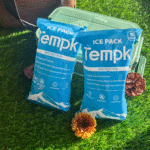Shipping Container Dry Ice Packs: Best Practices for Safe Transport of Perishables
Expédition de marchandises périssables telles que de la nourriture, médicaments, and biological samples presents unique challenges that require strict temperature control throughout the transportation process. One of the most reliable methods to ensure that these items remain within their required temperature range is through the use of shipping container dry ice packs. Glace sèche, la forme solide de dioxyde de carbone (Co₂), offers exceptional cooling performance due to its ability to sublimate directly from solid to gas at -78.5°C (-109.3°F), leaving no water residue. This guide covers the essential practices, conformité réglementaire, and tips for effectively using dry ice in logistics.
-

-
What are shipping container dry ice packs, Et comment fonctionnent-ils?
-
How can dry ice packs improve the efficiency of cold chain logistics?
-
What are the benefits of using dry ice packs for temperature-sensitive goods?
-
How do you choose the right dry ice packs for your shipping needs?
What Are Shipping Container Dry Ice Packs, Et comment fonctionnent-ils?
Shipping container dry ice packs are designed for temperature-sensitive shipments and are an essential component in cold chain logistics. Dry ice sublimates at a low temperature, meaning it absorbs heat and maintains a cold environment for the duration of the shipment. When placed inside insulated shipping containers, these packs provide a stable, environnement froid, ensuring that products like pharmaceuticals, vaccins, fruit de mer, and other perishable goods arrive at their destination without spoilage or degradation.
Dry ice packs are typically available in various sizes, allowing businesses to choose the correct size based on their shipment’s duration, the type of goods being shipped, and the transportation conditions. They are particularly beneficial in situations where refrigeration or conventional ice packs would not be sufficient for maintaining the required temperatures.
How Do Shipping Container Dry Ice Packs Improve Cold Chain Efficiency?
Shipping container dry ice packs significantly enhance the efficiency and reliability of cold chain logistics in several key ways:
-
Precise Temperature Control: Dry ice helps maintain the required low temperatures for perishable goods, réduire le risque de détérioration, dégradation, or loss of efficacy.
-
Extended Transport Durations: Dry ice packs last longer than traditional ice packs, providing cooling over extended periods, making them ideal for long-distance or international shipments.
-
Versatility Across Industries: From pharmaceuticals to food and chemicals, dry ice packs are versatile enough to be used across multiple industries with varying temperature requirements.
-
Rentabilité: Because dry ice packs last longer, there is less need for replenishing the cooling medium, making it a more cost-effective solution for extended shipments.
Key Advantages of Using Dry Ice Packs for Temperature-Sensitive Goods
There are several advantages to using dry ice in shipping, especially when compared to conventional cooling methods such as gel packs or traditional ice. These benefits include:
-
Durée de conservation prolongée: Dry ice maintains lower temperatures over a longer period, ensuring that sensitive goods remain within the desired temperature range throughout their transport.
-
Efficacité spatiale: Dry ice is compact and fits into various container types, allowing businesses to maximize shipping space.
-
Économies de coûts: As dry ice lasts longer and requires fewer replacements during transit, it offers significant savings over ice or gel packs, especially for long-distance shipping.
| Avantage | Packs de glace sec | Packs de gel | Packs de glace |
|---|---|---|---|
| Contrôle de la température | Maintains freezing conditions | Suitable for moderate cooling | Effective for short-term cooling |
| Durée de refroidissement | 18-24 heures | 4-12 heures | Varies with environment |
| Rentabilité | Long-lasting and efficient | Moins efficace | Less effective for longer shipments |
| Adéabilité pour les biens sensibles | Idéal pour les produits pharmaceutiques, fruit de mer, vaccins | Best for short trips or non-critical items | Good for less delicate goods |
Comment choisir le pack de glace carbonique adapté à vos besoins d'expédition?
Selecting the right dry ice pack for your shipping needs is crucial for ensuring your products remain within the required temperature range. The following factors should be considered:
-
Type de produit: Par exemple, vaccines and pharmaceuticals may require more precise temperature control than perishable food items like seafood.
-
Durée d'expédition: Longer shipping durations may require more or larger dry ice packs to maintain the appropriate temperature throughout the journey.
-
Conditions environnementales: External factors, such as temperature and humidity, can affect how quickly dry ice sublimates, so understanding the transport environment is critical.
Par exemple, shipping vaccines internationally will require more dry ice and better insulation than sending seafood for overnight transport.
Best Practices for Shipping with Dry Ice Pack Sheets
Dry ice pack sheets offer a flexible, reusable solution for shipping temperature-sensitive goods. These sheets are particularly useful for shipments requiring consistent low temperatures over an extended period.
Pre-Chill Items
Before packing your goods, ensure that they are pre-chilled to reduce the amount of dry ice needed. This helps the dry ice work more efficiently, ensuring that the cold chain is maintained for as long as necessary.
Calculate Dry Ice Quantity
Utiliser le 5-10 livres par 24 hours rule of thumb to determine the right amount of dry ice for your shipment. Larger shipments or those requiring lower temperatures may require more dry ice.
Surveiller la température
Using temperature indicators or real-time monitoring systems can help you track the internal conditions of the shipping container, ensuring that your products remain within acceptable temperature ranges throughout transit.
Ventilation appropriée
Ensure that the shipping container allows CO₂ gas to vent. Sans ventilation adéquate, la pression peut s'accumuler, potentially damaging the container or compromising the safety of the shipment.
Regulatory Considerations for Shipping with Dry Ice
Shipping dry ice involves several important regulations, as dry ice is classified as a hazardous material under UN1845. Key regulations include:
-
Étiquetage et documentation: Packages must be clearly marked with “Glace sèche” ou “Dioxyde de carbone, Solide,” the UN number (UN1845), and the net weight in kilograms. A Shipper’s Declaration for Dangerous Goods may also be required.
-
Packaging Requirements: Use containers that allow CO₂ gas to escape and are strong enough to withstand transportation stresses, including vibration and temperature changes.
-
Limites de quantité: There are limits on the amount of dry ice that can be shipped per package, especially for air transport. Most carriers adhere to these limits to ensure the safety of all involved.
2025 Tendances de l'expédition de la glace sèche
L'industrie de la logistique de la chaîne du froid évolue, with several key trends shaping the future of dry ice usage:
-
Sustainability Initiatives: As the demand for dry ice grows, efforts to reduce its environmental impact are underway. Companies are exploring ways to produce dry ice more sustainably and reduce carbon footprints.
-
IoT-Enabled Temperature Monitoring: Real-time tracking systems allow businesses to monitor shipments more closely, ensuring that dry ice maintains the necessary temperature throughout transport.
-
Solutions de refroidissement hybrides: Combining dry ice with phase-change materials (PCMS) or gel packs is becoming more common, as it reduces dry ice consumption and extends cooling durations.
FAQs About Dry Ice Shipping
Q: How long do dry ice packs last during shipping?
La glace sèche dure généralement 18-24 heures, depending on the size of the pack, the shipping conditions, and the insulation of the container.
Q: Is dry ice safe to handle during shipping?
Oui, Mais il doit être géré avec soin. Ensure that packaging allows for proper ventilation and that personnel are trained on safety guidelines to prevent injuries like frostbite or suffocation.
Conclusion et prochaines étapes
En conclusion, shipping container dry ice packs are essential for ensuring the safe and efficient transport of perishable goods. Their ability to maintain extremely low temperatures over extended periods makes them indispensable for industries like pharmaceuticals, nourriture, et biotechnologie.
Étapes suivantes:
-
Evaluate your shipping requirements and determine the amount of dry ice necessary for each shipment.
-
Train your team on dry ice handling and safety protocols.
-
Choose the right containers to minimize sublimation and maximize cooling efficiency.
À propos du tempk
Et tempk, we specialize in providing state-of-the-art cold chain solutions designed to meet the needs of our customers. From dry ice packs to advanced insulation systems, our products help you maintain the integrity of temperature-sensitive shipments.
Contactez-nous aujourd'hui to explore how we can optimize your cold chain logistics and ensure your goods are transported safely and efficiently.























